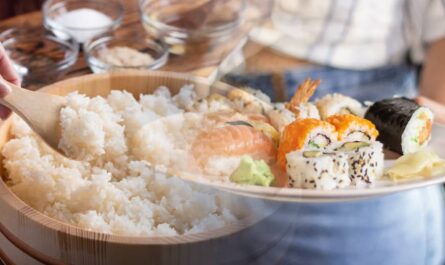For those passionate about sushi, understanding the traditional materials used in sushi tools can deepen one’s appreciation for this art. These tools, rooted in history, have been integral to sushi’s evolution. Let’s delve into the time-honored materials that have stood the test of time.

The Significance of Traditional Materials in Sushi Tools
When crafting sushi, the right tools play a pivotal role. The materials utilized in these tools aren’t just chosen for functionality but also for the cultural and aesthetic value they bring to the sushi-making process.
Wooden Wonders: The Role of Wood in Sushi Tools
Wood has always been a staple in crafting sushi tools. Its organic nature harmonizes with the sushi’s fresh and natural essence. For example, the hangiri, a traditional rice-cooling tub, is primarily made using cypress wood. For more on how it’s utilized, explore this cooling sushi rice guide.
Bamboo’s Versatility in Sushi Preparation
Bamboo is another material frequently used. From rolling mats to chopsticks, its flexibility and strength are unmatched. However, it requires careful maintenance to prevent mold. Check out these tips to avoid mold.
Stone and its Timeless Appeal
The traditional mortars and pestles, often made from stone, have been used for ages to grind ingredients to the perfect consistency. Their weight and texture make them indispensable in a sushi chef’s toolkit.
Metal Tools in the Sushi World
While wood and bamboo dominate, metal tools have carved their niche. High-quality knives primarily made from stainless steel or sometimes high-carbon steel are essential for precision cutting.
Ceramics and Porcelain: A Touch of Elegance
From serving dishes to storage containers, ceramics and porcelain add an element of sophistication. These materials are not only visually appealing but also serve practical purposes in sushi preparation.
The Role of Plastic: Modern Innovations
While traditionalists might frown upon it, plastic has found its way into modern sushi tools. It offers affordability and ease of cleaning, though it lacks the aesthetic charm of traditional materials. Curious about alternatives? Discover how sushi can also be rolled using plastic wrap.
FAQs
Why are traditional materials preferred in sushi tools?
Traditional materials like wood and bamboo are chosen for their natural affinity with fresh ingredients, enhancing the overall sushi experience.
Are modern materials replacing traditional ones?
No, while modern materials are popular, traditional ones remain unparalleled in authenticity and cultural significance.
How do I maintain my bamboo sushi mat?
Ensure it’s kept dry after use and occasionally treated with vinegar to prevent mold. For a detailed guide, visit this guide.

Conclusion
The blend of tradition and functionality in sushi tools is a testament to the art and culture surrounding sushi. Embracing these materials not only heightens the sushi-making process but also connects us to a rich heritage. For a deeper understanding of sushi etiquette, consider reading this sushi etiquette guide.
This article contains affiliate links. We may earn a commission at no extra cost to you.




